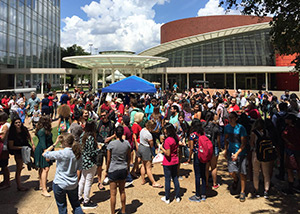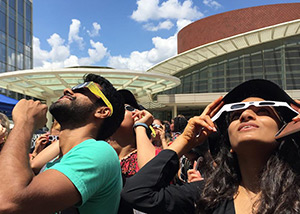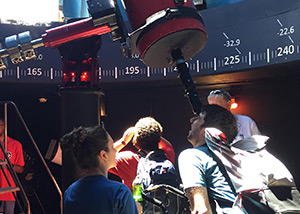
Solar Eclipse Activities Create Memorable First Day of Class
UH Physics and Astronomy Society Event Featured Telescopes, Safety Glasses and Observatory Tours
On August 21, the solar eclipse made its way across the country delighting millions of enthusiasts.
 See Related Video At University of Houston, nearly 1,800 people toured the UH Observatory to catch a glimpse of the eclipse through the big telescope. Even more stopped outside Science & Research 1 to see the eclipse through safety glasses, small telescopes and pinhole projection assemblies.
See Related Video At University of Houston, nearly 1,800 people toured the UH Observatory to catch a glimpse of the eclipse through the big telescope. Even more stopped outside Science & Research 1 to see the eclipse through safety glasses, small telescopes and pinhole projection assemblies.
August 21 was also the first day of the fall semester, meaning that for students, their first day was truly a once-in-a-solar-eclipse event.
Multiple Ways to View Eclipse
To celebrate this rare occurrence, the Astronomy Society of UH hosted viewing opportunities in the grassy area between Science & Research 1 and the Science and Engineering Classroom Building. A second viewing location was set up on the lawn between the Classroom and Business Building and the Student Center North.
 At the demonstration tent, telescopes with solar filters and pinhole projection assemblies allowed safe viewing of the sun. Thanks to funds provided by the College of Natural Sciences and Mathematics, there was also a safety goggle station where people could view the eclipse with the naked eye.
At the demonstration tent, telescopes with solar filters and pinhole projection assemblies allowed safe viewing of the sun. Thanks to funds provided by the College of Natural Sciences and Mathematics, there was also a safety goggle station where people could view the eclipse with the naked eye.
The UH Observatory on top of Science & Research 1 was open to the general public, students, faculty and staff.
“We wanted to help people understand more about what a solar eclipse is, and how it happens,” said Fre’Etta Brooks, a senior physics major, and the president of the Astronomy Society.
Observatory Renovated by Astronomy Society
The UH Observatory, which was out of commission for several years, is now operational thanks to the hard work of the Astronomy Society, and the financial support of the Department of Physics. During the renovations, which were initiated and supervised by curator Susan Street and former co-curator Carlos Gramajo, the Astronomy Society refurbished the observatory and repaired much of the equipment.
 The mount installation, paid for by the physics department, is an automatic steering mount which allows for a high accuracy of tracking objects across the sky and enables long-term viewing of moving objects.
The mount installation, paid for by the physics department, is an automatic steering mount which allows for a high accuracy of tracking objects across the sky and enables long-term viewing of moving objects.
Since 2016, the Astronomy Society has grown to 70 members, hosting monthly meetings, bringing in guest lecturers, and holding regular observation nights.
“During the solar eclipse demonstrations, we wanted visitors to learn that the observatory is a great campus resource, and that the Astronomy Society is a welcoming society, open to all majors,” Brooks said.
Susan Street serves as the curator for the observatory, assistant professor of physics Andrew Renshaw serves as faculty advisor for the observatory and associate professor of physics Donna Stokes serves as faculty advisor for the Astronomy Society.
Rachel Fairbank, College of Natural Sciences and Mathematics